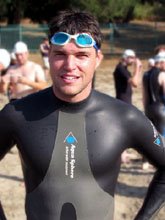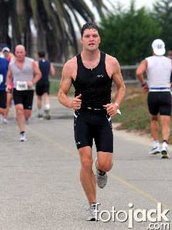This past weekend I attended a fitness expo at the Los Angeles Convention Center. Along with the predictable booths shilling various fitness-oriented products were some altogether more interesting types: diminutive power lifters hoisting three times their body weight; beer-bellied strongmen muscling around what appeared to be outsized bowling balls; mixed martial artists demonstrating their facility with cracking bones.
In one corner, reps from the American Gladiators show were counting the pull-ups and squat thrusts being churned out by next season’s hopefuls, whilst a few short steps away, the Gladiators themselves were fielding questions from a rapt audience. I was tempted, but I didn’t audition: running “The Eliminator” holds some appeal for me, but getting repeatedly blindsided by a 280-pound behemoth. So instead of auditioning, I stood there and tried to evaluate their testing parameters on the basis of their ability to actually predict aptitude for the American Gladiators competition.
I also attended a talk given by Dr. Tom Deters, who had some wise things to say about eating for fat loss. Although he did espouse two oldish school practices whose effectiveness has recently been questioned--namely fasted morning steady-state cardio training and a diet of 65% carbohydrate--his perspective was nonetheless very interesting to hear, and continues to be effective for a lot of people. Different strokes.
Because a pair of bodybuilding competitions served as the central event of the weekend, most of the products being shilled revolved around building muscles and showing them off to maximum effect: mass-building protein powers, skin-darkening tanning products, fat-incinerating capsules. The MMA guys, powerlifters and Gladiators notwithstanding, this was an event for people who wanted to get BIG; and if the scantily-clad ring-girl types who stood behind many of the booth tables were any indication, the primary audience was GUYS.
Now I’m not going to bemoan the reality of supply and demand: as icons down through the ages have shown us, muscles—even muscles devoid of true functionality--sell. Joe Weider and others have made fortunes by offering the salve of massive muscularity to quell the insecurities of adolescent boys. I often wonder whether part of the fetishistic appeal of publications like MUSCLE AND FITNESS is that the huge pecs and swooping, curvy body lines on display offer impressionable teen readers a Freudian association with the feminine form.
The saddish fact is that in common parlance, “bodybuilding” has become a de facto synonym for “fitness.” Overwhelmingly, what was on sale at the “fitness” expo were massive, shrink-wrapped muscles whose owners may or may not be capable of climbing a set of stairs or touching their toes without the aid of a pallet jack.
This is, to quote Fred Willard, “ironical.”
Now, for most people, building a few extra pounds of contractile tissue is a pretty good corrective to many of the physical woes that ail our sedentary society. Like Alwyn Cosgrove, Lou Schuler, and many of the other fitness folks I admire, I believe that if you’ve got just three hours a week to spare for exercise, you really can’t go too far wrong spending it in the weight room, chugging away on the basic exercises that have been with us since man invented barbell. And heck, I’ll be the first to admit that images of well-developed men and women can be a pretty powerful inspirational tool.
Still, I think it’s a little bit unfortunate Weider and his ilk can now lift a cognac to the near-wholesale appropriation of the fitness industry by bodybuilding enthusiasts. Bodybuilding, as Tom Deters mentioned in his lecture, is an extreme sport, rather like ultra-marathoning or free-climbing or BASE jumping. Developing a stage-worthy bodybuilder’s physique almost always involves copious drug use, extreme training, a fanatical attention to food, and a to-the-minute approach to sleep.
Is this the kind of lifestyle that the fitness industry should be promoting? Is it rewarding, fun, healthy, even?
I recently read an article in an old FLEX magazine about a day in the pre-contest life of Ronnie Coleman, who was Mr. Olympia for many years. Most of his days, it seems, were spent in repose. Sure, he trained hard for ninety minutes a day, and he ingested enormous meals and mounds of supplements at meticulously-times intervals, but the rest of his time was spent lounging about, refraining from extraneous activity, waiting for his muscles to grow. Whether or not to make an impromptu trip to the airport to pick up a friend was a major decision: could he risk being 15 minutes late for his 7 PM date with a protein shake? For the most part, Coleman passed his glory days like a hypertrophied hen perched expectantly on her prize egg.
All props to Coleman for his dedication, but should we really be turning to people like him for Everyman advice on how to get fit?
Six months ago I embarked on a little bodybuilding quest myself, and managed to add about fifteen pounds of beef through heavy lifting, gluttonous eating, and careful control of extracurricular activities.
People told me I looked buff. My training weights soared. I began wearing really tight t-shirts even when it was cold. Even my wife, who claims not to notice or care about such things, noticed my transformation (She kept rolling her eyes and asking, “When are you going to stop this?”). So in some respects, my experiment was a success.
In the process, though, I also injured my back twice. I developed chronic tendonitis in one elbow, and some instability in my right shoulder. On most days I was in some kind of additional workout-induced pain as well. Getting out of the car was a hassle. My flexibility suffered. I had to pound protein shakes at all hours to feed my hungry muscles. With the additional weight of my extra muscle mass, my knees couldn’t take the pounding of even a quick jog around the block. . I could barely keep up with my four-year-old in a game of tag. I moved more stiffly, and for the first time in my life, started to feel…old. I wondered if this was going to be it for me.
So a few weeks ago I shifted things: three weight workouts a week instead of four, plus two more days of other athletic activities: running, cycling, hitting the heavy bag, calesthenics, interval training. I shifted the weight workouts to more athletic moves like power cleans and Tabata squats. I wouldn’t try to shed the extra muscle weight, exactly, I’d just go back to being a generalist instead of being so myopic in my focus on packing on the beef.
And, no surprise, I suppose, I feel much better. I’ve got my running wheels back. I’m back feeling good doing athletic things, being able to move quickly and without pain. I FEEL more like a trainer should feel, even if I don’t LOOK as much like one as I did eight weeks ago.
So there’s the paradox: the fitness industry has fed us a model of fitness that is all about looking a certain way, with very little attention to feeling good or performing particularly well. If you’ve got big guns a six-pack, well then, you must be fit. But there’s a whole lot more to it than that.
The great irony of ‘American Gladiators’ is that although the show’s stars are hypertrophied WWF-types, the contestants who prevailed in the contest were trim, prototypically athletic-looking types. They’re fitness generalists, strong and muscular, certainly, but also quick and agile, with excellent strength-to-weight ratio. If you’re talking about real-world fitness, the kind of fitness that feels good AND looks good, that will help you schlep your four-year-old around AND catch the bus as it’s pulling away, that will keep you going in a pick-up game of Ultimate Frisbee AND enable you to help your buddy move into his new third-floor walkup, that’s the type of physique to go for. If you’re trying to build that type of body, muscle-building may indeed be a part of the equation, but it doesn’t—and shouldn’t—stop there.
Tuesday, February 26, 2008
Subscribe to:
Post Comments (Atom)




1 comment:
Amen to that! I totally agree that there should be a definite distinction between fitness and hypertrophy. Thanks for sharing your own experience with the realities of living the hypertrophy-centered approach. Sure, the results are aesthetically pleasing, but it really doesn't sound worth it to keep that up for any length of time. I appreciate your regular dose of perspective to cut through the hype.
Post a Comment